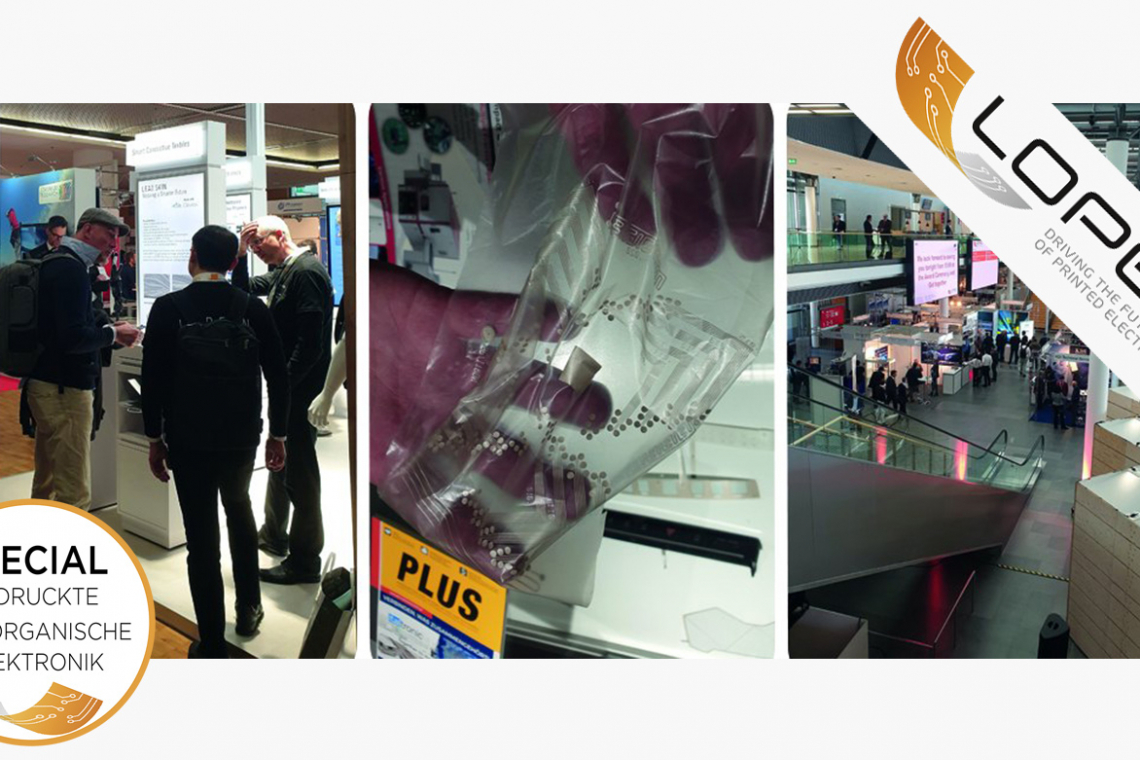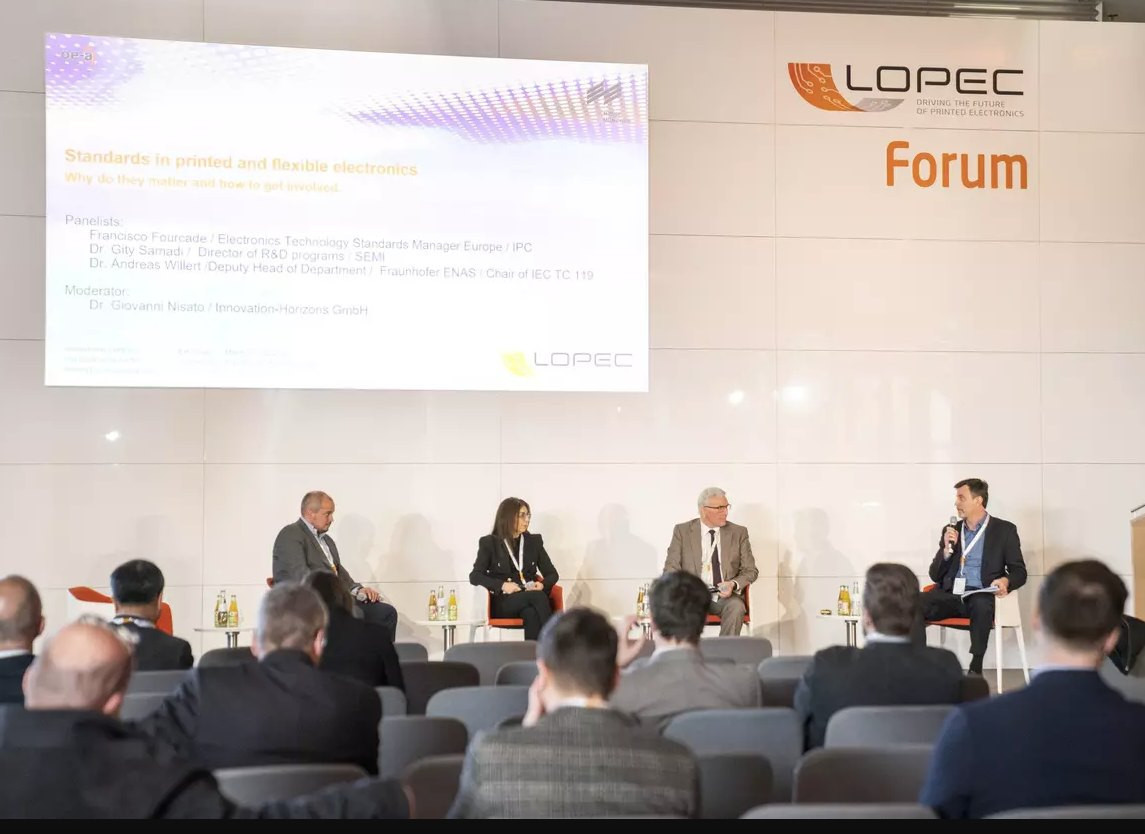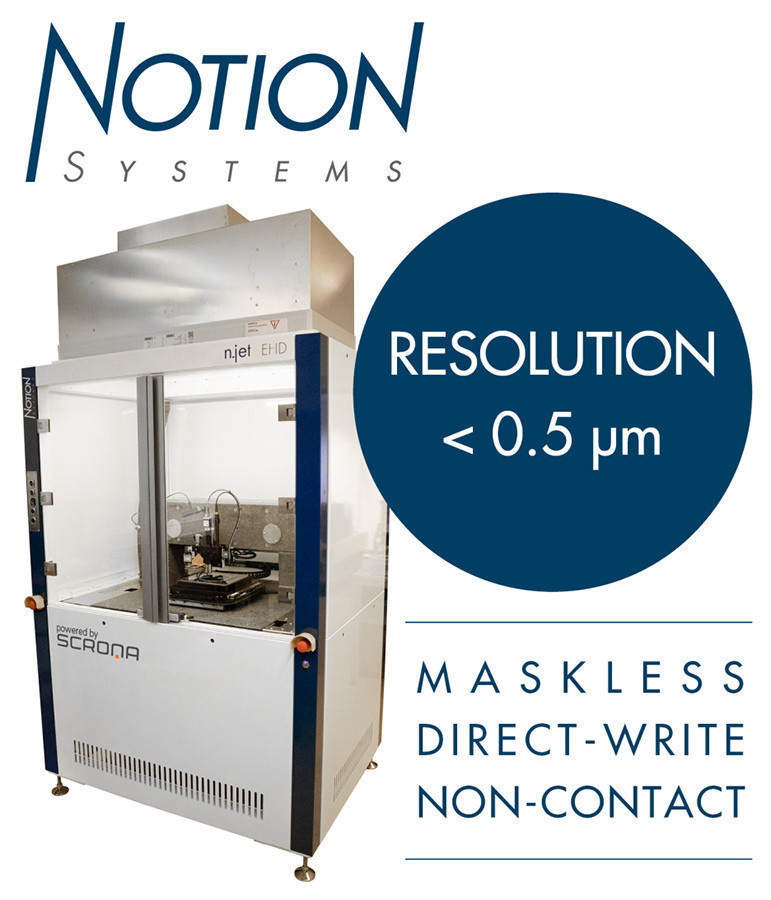LOPEC (Large-area, Organic & Printed Electronics Convention) is probably the most important trade fair and conference for flexible, organic and printed electronics. Every year it brings together players from research, production and application from all continents in the Bavarian metropolis of Munich. The combination of trade fair and conference enables visitors to get to know future technologies in the field and assess their potential. The conference presentations from 22 countries in particular aroused great interest and were very well attended. PLUS also listened to several presentations (see PLUS 3/2023, p. 358), including one by Ezgi Inci Yesilyurt from the Leibniz Institute of Polymer Research in Dresden, who spoke about a screen printing approach for electrode production. We were able to obtain her extremely interesting work for the technology section of this issue.
The survey of trade fair visitors in 2023 yielded interesting results. The majority of the 2,400 visitors from 43 countries described themselves as important decision-makers in their companies (86%) - and the overwhelming majority stated that the importance of LOPEC will continue to grow (99%) and that they would also like to visit the trade fair in 2024 (98%). The 167 exhibitors were equally satisfied: 98% want to exhibit at the trade fair in 2024. Accordingly, the trade fair stands are already occupied by companies that will be presenting their innovations in printed and organic electronics.
Focus topics at the LOPEC 2024
Smart living
The trade fair will showcase printed electronics products and applications that are designed to make our everyday lives simpler, smarter and more environmentally friendly. These include a new generation of fitness trackers, 'smart' textiles and pharmaceutical packaging as well as self-adhesive solar films.
Mobility
Printed electronic components are opening up new opportunities and possibilities for the automotive and aviation industries. From sensors in passenger seats and electrochromic windows to ultra-flat touchscreens in the cockpit: numerous applications of printed electronics and 3D structural electronics are already in use today or are close to series production. For example, printed heating elements are becoming increasingly important in electric cars. As electric motors generate significantly less waste heat for heating than petrol and diesel engines, printed, lightweight and super-flat heating elements in the seats and behind door and side panels ensure pleasant temperatures inside the vehicle. An electrochromic layer, which is printed on the back of the mirror or between flat panes of glass, also enables infinitely variable color changes or opacity at the touch of a button or by automatic control.
Design and haptics in the automotive sector
Printed electronics can be integrated into the curved surfaces of flexible touchscreens. The direct combination of design and electronic functionality through 3D structural electronics or in-mold electronics enables innovative human-machine interfaces while reducing weight and the number of components required. Mechanical switches can be replaced by tactile operating elements with haptic feedback. Organic light-emitting diodes (OLEDs) will increasingly be seen on the exterior of vehicles, as they can be printed on film, are extremely flexible and can be easily adapted to curved shapes.
Sustainability
The flexible, organic and printed electronics industry has moved to mass production. This goes hand in hand with an awareness of the responsibility that production and use have for the climate and environment. LOPEC is therefore dedicated to the production processes and the basic technology, also from the point of view of sustainability. PE printing processes are very energy-efficient compared to conventional production processes. Less material is used in the additive printing process and the amount of waste that needs to be disposed of or treated is greatly reduced.
Round Table: Sustainability, circular economy and printed electronics
Wednesday, March 6, 3:00 pm in the LOPEC Forum, Foyer of the ICM
Applications for printed electronics range from solar energy, medicine and pharmaceuticals, logistics, printing and graphics to lighting. Key features of printed electronics production often cited include additive, 'smart' and low-temperature manufacturing processes, which have less impact on the environment than the production of conventional electronics.
New developments in electronics must not only offer appropriate performance, allow customization to the end user and be producible at a competitive cost, but also meet a growing number of environmental requirements. Here, printed electronics offer decisive advantages for ecological sustainability - especially as the European Commission, among others, is co-financing research and development in the field of functional electronics for an ecological circular economy. The round table at LOPEC 2024 will discuss these topics and ask how an economically viable balance between application performance, sustainability and circular economy can be achieved.
Recommendations for the Lopec printed electronics conference communication platform
The founder and CEO of GenesInk, a developer and supplier of nanoparticles and hybrid nanocomposites for active inks, will talk about the production of functional nanoinks - from particles to large-scale production. Corinne Versini, who is also a member of the LOPEC Advisory Board, will share her expertise on the creation of transparent, conductive films with nanoinks and organic, flexible, printed electrical devices.
Dr. Schumacher, a physicist specializing in thin-film physics and technologies, works at the Luxembourg-based company IEE S.A. on the development of sensor solutions and electronic manufacturing services for the automotive industry, building management, security and medical technology. In his role as Vice President of the OE-A, he also speaks generally about the potential of printed electronics for society to better meet the challenges of smart living, medicine, healthcare, IoT, digitalization and autonomous mobility. Schumacher will present the results of the OE-A roadmap and the potential of the technology for a circular economy. The lecture promises to provide an overview of the most important innovations in the field of printed electronics, and Schumacher will present mass products based on printed electronics that are now possible and could revolutionize electronics manufacturing.
In PLUS issue 8/2023, we already reported on the 'HyPELignum' project, in which ecologically sustainable cellulose-based circuit boards also promise exciting potential applications for the printed circuit board industry. Here, printed electronics and 'classic' established PCB technology could result in hybrid forms of production. Ruben Griffith reports on the latest results.
PhD Giulia Frusconi presents research results of the Italian University of Brescia on OECTs as building blocks of bioelectronics. Their production is still costly and complicated. However, photolithography, which uses a polar solvent and replaces costly etching, achieves significantly better scalability, consistency and transconductance. The resulting OECTs can find application in ion sensing. Undoubtedly an exciting approach that we do not want to miss.
Printed piezoelectric sensors can be used to detect and monitor structural deformation or damage in aircraft.
Printed temperature sensors are able to monitor temperature changes even in inaccessible places in engines. This sensor technology enables complete, continuous monitoring of the entire system in the aircraft, but can also be transferred to other areas of application. Important food for thought can be gained here for the important field of aero-mobility.
www.lopec.com, www.lopec.com/en/conference/
Competitions
Well received again this year: The 'OE-A Competition'
This year, 16 submissions from international companies, research institutes and universities are taking part in the 'OE-A Competition'. The projects will be judged by a jury of representatives from companies and institutes in three categories: 'Prototypes & New Products', 'Freestyle Demonstrator' and 'Publicly Funded Project Demonstrator'. There will also be an audience award - the 'Public Choice Award'. All trade fair visitors can vote for their favorite at the OE-A stand (FO 33). The award will be presented on Wednesday evening.
www.oe-a.org/topics/oe-a-working-groups/oe-a-launches-oe-a-competition-2024
'Student Open Innovation Challenge'
In addition to the established competition, the 'OE-A Working Group Education' and the company Henkel, itself a member of the OE-A, have for the first time announced an open innovation competition for students and graduates on the subject of 'Smart Living and Smart Mobility'. Young students are invited to develop innovative ideas for a printed electronics application in the Smart Living and Mobility markets and implement them as a prototype. The students were provided with the 'Henkel Sensor Kit' with various printed sensors for this purpose. The jury, consisting of the OE-A, Henkel and other industry representatives, will select the winner of the 'Open Innovation Challenge'. The winning project will be exhibited together with all other projects at the OE-A booth FO 33 at LOPEC.
www.oe-a.org/student-open-innovation-challenge-printed-electronics-for-smart-living-smart-mobility
Trade fair highlight
Notion Systems: Beyond Micro Scalable Additive Printing on the Nano Scale with EHD
Electrohydrodynamic printing (EHD) is a high-resolution printing technology that, compared to inkjet, generates droplets using electric fields, which enables maskless, direct and contactless additive structuring in the sub-micrometer range with highly viscous materials. EHD replaces established subtractive process sequences in electronics production, thereby reducing material and energy consumption by only applying the material where it is actually needed. At the same time, maskless EHD direct structuring can eliminate process steps in production and increase throughput, making electronics production more ecological and economical.
Together, Scrona and Notion Systems offer a fully comprehensive EHD platform with integrated MEMS printheads that provide up to one thousand digital and independently controllable nozzles. Thanks to special optical systems, high positioning accuracy, a specific software suite and the modularity of the platform, a complete EHD solution developed from the ground up is offered here. See for yourself with a live demonstration at our stand B0.606.
-Text: Notion Systems -












